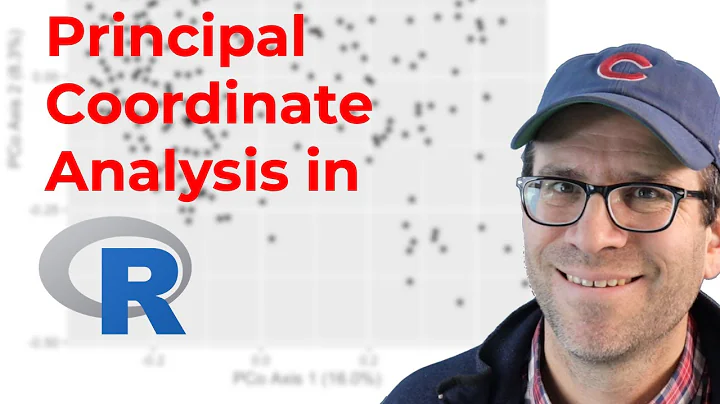PCA Scaling with ggbiplot
15,817
I edited the code for the plot function and was able to get the functionality I wanted.
ggbiplot2=function(pcobj, choices = 1:2, scale = 1, pc.biplot = TRUE,
obs.scale = 1 - scale, var.scale = scale,
groups = NULL, ellipse = FALSE, ellipse.prob = 0.68,
labels = NULL, labels.size = 3, alpha = 1,
var.axes = TRUE,
circle = FALSE, circle.prob = 0.69,
varname.size = 3, varname.adjust = 1.5,
varname.abbrev = FALSE, ...)
{
library(ggplot2)
library(plyr)
library(scales)
library(grid)
stopifnot(length(choices) == 2)
# Recover the SVD
if(inherits(pcobj, 'prcomp')){
nobs.factor <- sqrt(nrow(pcobj$x) - 1)
d <- pcobj$sdev
u <- sweep(pcobj$x, 2, 1 / (d * nobs.factor), FUN = '*')
v <- pcobj$rotation
} else if(inherits(pcobj, 'princomp')) {
nobs.factor <- sqrt(pcobj$n.obs)
d <- pcobj$sdev
u <- sweep(pcobj$scores, 2, 1 / (d * nobs.factor), FUN = '*')
v <- pcobj$loadings
} else if(inherits(pcobj, 'PCA')) {
nobs.factor <- sqrt(nrow(pcobj$call$X))
d <- unlist(sqrt(pcobj$eig)[1])
u <- sweep(pcobj$ind$coord, 2, 1 / (d * nobs.factor), FUN = '*')
v <- sweep(pcobj$var$coord,2,sqrt(pcobj$eig[1:ncol(pcobj$var$coord),1]),FUN="/")
} else {
stop('Expected a object of class prcomp, princomp or PCA')
}
# Scores
df.u <- as.data.frame(sweep(u[,choices], 2, d[choices]^obs.scale, FUN='*'))
# Directions
v <- sweep(v, 2, d^var.scale, FUN='*')
df.v <- as.data.frame(v[, choices])
names(df.u) <- c('xvar', 'yvar')
names(df.v) <- names(df.u)
if(pc.biplot) {
df.u <- df.u * nobs.factor
}
# Scale the radius of the correlation circle so that it corresponds to
# a data ellipse for the standardized PC scores
r <- 1
# Scale directions
v.scale <- rowSums(v^2)
df.v <- df.v / sqrt(max(v.scale))
## Scale Scores
r.scale=sqrt(max(df.u[,1]^2+df.u[,2]^2))
df.u=.99*df.u/r.scale
# Change the labels for the axes
if(obs.scale == 0) {
u.axis.labs <- paste('standardized PC', choices, sep='')
} else {
u.axis.labs <- paste('PC', choices, sep='')
}
# Append the proportion of explained variance to the axis labels
u.axis.labs <- paste(u.axis.labs,
sprintf('(%0.1f%% explained var.)',
100 * pcobj$sdev[choices]^2/sum(pcobj$sdev^2)))
# Score Labels
if(!is.null(labels)) {
df.u$labels <- labels
}
# Grouping variable
if(!is.null(groups)) {
df.u$groups <- groups
}
# Variable Names
if(varname.abbrev) {
df.v$varname <- abbreviate(rownames(v))
} else {
df.v$varname <- rownames(v)
}
# Variables for text label placement
df.v$angle <- with(df.v, (180/pi) * atan(yvar / xvar))
df.v$hjust = with(df.v, (1 - varname.adjust * sign(xvar)) / 2)
# Base plot
g <- ggplot(data = df.u, aes(x = xvar, y = yvar)) +
xlab(u.axis.labs[1]) + ylab(u.axis.labs[2]) + coord_equal()
if(var.axes) {
# Draw circle
if(circle)
{
theta <- c(seq(-pi, pi, length = 50), seq(pi, -pi, length = 50))
circle <- data.frame(xvar = r * cos(theta), yvar = r * sin(theta))
g <- g + geom_path(data = circle, color = muted('white'),
size = 1/2, alpha = 1/3)
}
# Draw directions
g <- g +
geom_segment(data = df.v,
aes(x = 0, y = 0, xend = xvar, yend = yvar),
arrow = arrow(length = unit(1/2, 'picas')),
color = muted('red'))
}
# Draw either labels or points
if(!is.null(df.u$labels)) {
if(!is.null(df.u$groups)) {
g <- g + geom_text(aes(label = labels, color = groups),
size = labels.size)
} else {
g <- g + geom_text(aes(label = labels), size = labels.size)
}
} else {
if(!is.null(df.u$groups)) {
g <- g + geom_point(aes(color = groups), alpha = alpha)
} else {
g <- g + geom_point(alpha = alpha)
}
}
# Overlay a concentration ellipse if there are groups
if(!is.null(df.u$groups) && ellipse) {
theta <- c(seq(-pi, pi, length = 50), seq(pi, -pi, length = 50))
circle <- cbind(cos(theta), sin(theta))
ell <- ddply(df.u, 'groups', function(x) {
if(nrow(x) < 2) {
return(NULL)
} else if(nrow(x) == 2) {
sigma <- var(cbind(x$xvar, x$yvar))
} else {
sigma <- diag(c(var(x$xvar), var(x$yvar)))
}
mu <- c(mean(x$xvar), mean(x$yvar))
ed <- sqrt(qchisq(ellipse.prob, df = 2))
data.frame(sweep(circle %*% chol(sigma) * ed, 2, mu, FUN = '+'),
groups = x$groups[1])
})
names(ell)[1:2] <- c('xvar', 'yvar')
g <- g + geom_path(data = ell, aes(color = groups, group = groups))
}
# Label the variable axes
if(var.axes) {
g <- g +
geom_text(data = df.v,
aes(label = varname, x = xvar, y = yvar,
angle = angle, hjust = hjust),
color = 'darkred', size = varname.size)
}
# Change the name of the legend for groups
# if(!is.null(groups)) {
# g <- g + scale_color_brewer(name = deparse(substitute(groups)),
# palette = 'Dark2')
# }
# TODO: Add a second set of axes
return(g)
}

Related videos on Youtube
Author by
scs217
Updated on June 17, 2022Comments
-
 scs217 almost 2 years
scs217 almost 2 yearsI'm trying to plot a principal component analysis using
prcompandggbiplot. I'm getting data values outside of the unit circle, and haven't been able to rescale the data prior to callingprcompin such a way that I can constrain the data to the unit circle.data(wine) require(ggbiplot) wine.pca=prcomp(wine[,1:3],scale.=TRUE) ggbiplot(wine.pca,obs.scale = 1, var.scale=1,groups=wine.class,ellipse=TRUE,circle=TRUE)I tried scaling by subtracting mean and dividing by standard deviation before calling
prcomp:wine2=wine[,1:3] mean=apply(wine2,2,mean) sd=apply(wine2,2,mean) for(i in 1:ncol(wine2)){ wine2[,i]=(wine2[,i]-mean[i])/sd[i] } wine2.pca=prcomp(wine2,scale.=TRUE) ggbiplot(wine2.pca,obs.scale=1, var.scale=1,groups=wine.class,ellipse=TRUE,circle=TRUE)ggbiplotpackage installed as follows:require(devtools) install_github('ggbiplot','vqv')Output of either code chunk:

Per @Brian Hanson's comment below, I'm adding an additional image reflecting the output I'm trying to get.

-
 doctorate over 10 years+1, this fx is much improved now, all points inside, but my question, can this function accept principal object of psych package? I end up with different figures using stats::prcomp().
doctorate over 10 years+1, this fx is much improved now, all points inside, but my question, can this function accept principal object of psych package? I end up with different figures using stats::prcomp().









